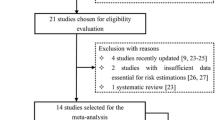Abstract
To systematically evaluate the association between poly(ADP-ribose) polymerase 1 (PARP1) rs1136410 T>C and brain tumor risk, a meta-analysis has been carried out. We performed a meta-analysis of 2004 brain tumor patients and 2944 controls by use of STATA version 12.0 to determine whether the risk of brain tumors was associated with the genotypes or alleles of rs1136410 T>C. We found a significantly decreased risk (ranging from 0.18- to 0.16-fold) in the dominant model (OR = 0.84, 95 % CI = 0.75–0.95), the C vs. T model (OR = 0.82, 95 % CI = 0.74–0.91), and the CT vs. TT model (OR = 0.86, 95 % CI = 0.76–0.98). The same genetic models demonstrated noteworthy associations when analysis was restrained to glioma (OR = 0.85, 95 % CI = 0.75–0.96; OR = 0.83, 95 % CI = 0.74–0.92; OR = 0.87, 95 % CI = 0.76–0.99, respectively). This meta-analysis suggests that PARP1 rs1136410 T>C may play a significant role in the protection against the development of brain tumors and glioma.



Similar content being viewed by others
References
Bondy ML, Scheurer ME, Malmer B et al (2008) Brain tumor epidemiology: consensus from the Brain Tumor Epidemiology Consortium. Cancer 113(7 Suppl):1953–1968
Momiyama M, Suetsugu A, Kimura H et al (2013) Imaging the efficacy of UVC irradiation on superficial brain tumors and metastasis in live mice at the subcellular level. J Cell Biochem 114(2):428–434
Schwartzbaum JA, Fisher JL, Aldape KD, Wrensch M (2006) Epidemiology and molecular pathology of glioma. Nat Clinical Pract Neuro 2(9):494–503, quiz 491 p following 516
Qin LY, Zhao LG, Chen X, Li P, Yang Z, Mo WN (2014) The CCND1 G870A gene polymorphism and brain tumor risk: a meta-analysis. Asia Pac J Cancer Prev : APJCP 15(8):3607–3612
Zhou P, Wei L, Xia X, Shao N, Qian X, Yang Y (2014) Association between telomerase reverse transcriptase rs2736100 polymorphism and risk of glioma. J Surg Res
Xin Y, Hao S, Lu J, Wang Q, Zhang L (2014) Association of ERCC1 C8092A and ERCC2 Lys751Gln polymorphisms with the risk of glioma: a meta-analysis. PLoS ONE 9(4):e95966
Shete S, Hosking FJ, Robertson LB et al (2009) Genome-wide association study identifies five susceptibility loci for glioma. Nat Genet 41(8):899–904
Wrensch M, Jenkins RB, Chang JS et al (2009) Variants in the CDKN2B and RTEL1 regions are associated with high-grade glioma susceptibility. Nat Genet 41(8):905–908
Tudek B (2007) Base excision repair modulation as a risk factor for human cancers. Mol Asp Med 28(3–4):258–275
Gossage L, Perry C, Abbotts R, Madhusudan S (2012) Base excision repair factors are promising prognostic and predictive markers in cancer. Curr Mol Pharmacol 5(1):115–124
Kothandapani A, Sawant A, Dangeti VS, Sobol RW, Patrick SM (2013) Epistatic role of base excision repair and mismatch repair pathways in mediating cisplatin cytotoxicity. Nucleic Acids Res 41(15):7332–7343
Malanga M, Althaus FR (2005) The role of poly(ADP-ribose) in the DNA damage signaling network. Biochim Biol Cell 83(3):354–364
Guerrero-Preston R, Hadar T, Ostrow KL et al (2014) Differential promoter methylation of kinesin family member 1a in plasma is associated with breast cancer and DNA repair capacity. Oncol Rep 32(2):505–512
Schuler N, Palm J, Kaiser M et al (2014) DNA-damage foci to detect and characterize DNA repair alterations in children treated for pediatric malignancies. PLoS ONE 9(3):e91319
Lockett KL, Hall MC, Xu J et al (2004) The ADPRT V762 Agenetic variant contributes to prostate cancer susceptibility and deficient enzyme function. Cancer Res 64(17):6344–6348
Zhang X, Miao X, Liang G et al (2005) Polymorphisms in DNA base excision repair genes ADPRT and XRCC1 and risk of lung cancer. Cancer Res 65(3):722–726
Liu Y, Scheurer ME, El-Zein R et al (2009) Association and interactions between DNA repair gene polymorphisms and adult glioma. Cancer Epidemiol Biomark Prev : Publ Am Assoc Cancer Res cosponsored by the Am Soc Prev Oncol 18(1):204–214
Rajaraman P, Hutchinson A, Wichner S et al (2010) DNA repair gene polymorphisms and risk of adult meningioma, glioma, and acoustic neuroma. Neuro-Oncology 12(1):37–48
Yosunkaya E, Kucukyuruk B, Onaran I, Gurel CB, Uzan M, Kanigur-Sultuybek G (2010) Glioma risk associates with polymorphisms of DNA repair genes, XRCC1 and PARP1. Br J Neurosurg 24(5):561–565
McKean-Cowdin R, Barnholtz-Sloan J, Inskip PD et al (2009) Associations between polymorphisms in DNA repair genes and glioblastoma. Cancer Epidemiol, Biomark Prev : Publ Am Assoc Cancer Res, cosponsored by the Am Soc Prev Oncol 18(4):1118–1126
Wells GA, Shea B, OʼConnell D, Peterson J, Welch V, Losos M, Tugwell P. The Newcastle-Ottawa Scale (NOS) for assessing the quality of nonrandomised studies in meta analyses. Available online: http://www.ohri.ca/programs/clinical_epidemiology/oxford.asp
Mantel N, Haenszel W (1959) Statistical aspects of the analysis of data from retrospective studies of disease. J Natl Cancer Inst 22(4):719–748
DerSimonian R, Laird N (1986) Meta-analysis in clinical trials. Control Clin Trials 7(3):177–188
Wg C (1954) The combination of estimates from different experiments. Biometrics 10:101–129
Egger M, Davey Smith G, Schneider M, Minder C (1997) Bias in meta-analysis detected by a simple, graphical test. BMJ 315(7109):629–634
Jemal A, Siegel R, Ward E, Hao Y, Xu J, Thun MJ (2009) Cancer statistics, 2009. CA: Cancer J Clin 59(4):225–249
Ohgaki H, Kleihues P (2005) Epidemiology and etiology of gliomas. Acta Neuropathol 109(1):93–108
China NBoSo. China’s Health Statistics Yearbook 2009 [in Chinese]. Peking, China: Peking Union Medical College Press; 2009:254. (http://www.moh.gov.cn/publicfiles/business/htmlfiles/zwgkzt/ptjnj/year2009/t-9.htm). 2010
Funding
None.
Author information
Authors and Affiliations
Corresponding author
Rights and permissions
About this article
Cite this article
Wang, H., Zhang, K., Qin, H. et al. Association Between PARP1 Single Nucleotide Polymorphism and Brain Tumors. Mol Neurobiol 53, 2083–2089 (2016). https://doi.org/10.1007/s12035-015-9168-4
Received:
Accepted:
Published:
Issue Date:
DOI: https://doi.org/10.1007/s12035-015-9168-4




